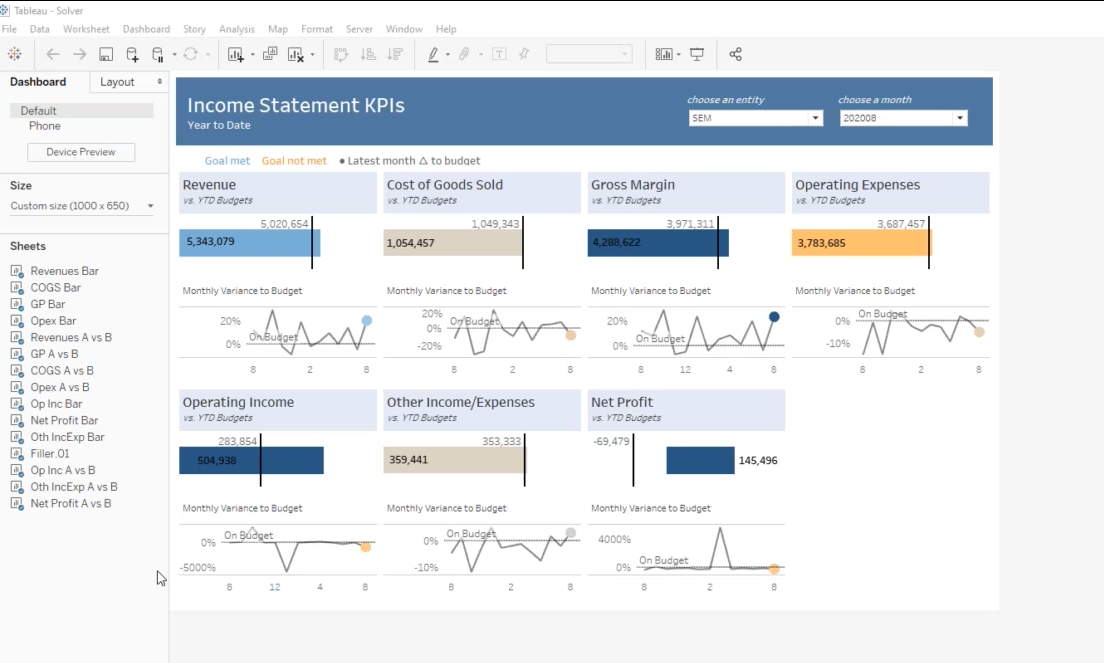Financial Reporting and Planning Integrated with Tableau Dashboards
Tableau is a leading visualization tool used by companies world-wide to enable easy data analysis with interactive dashboards. However, to drive faster and better decisions across the organization, the benefits multiply when Tableau is delivered with a directly integrated with Planning and Financial Reporting solution.
What is the difference between Dashboards, Financial Reports and Planning Tools?
Mostly thanks to vendors mixing terminologies, many people have a hard time distinguishing between dashboards, financial reporting and planning solutions. Here is a simple set of definitions:
- Dashboard Tools are usually single screen interactive visualizations, most often focused on summary metrics and KPIs.
- Financial Reporting Tools are purpose-built to enable highly formatted reports such as profit & loss, balance sheet and cash flow statements. Usually with functionality for consolidations, currency conversion and other features to help speed up the month-end close.
- Planning Tools provide user-friendly data entry input forms to capture annual budgets and forecasts. They use workflow to manage the submission and approval process.
All the tools above provide flexibility for trained users to design their own layouts, something which enables these technologies to work across all industries. Here is a page with 100’s of formatted examples.
Dashboard tools like Tableau fall into a category of software referred to as Business Intelligence (BI), and financial reporting and planning tools belong to a category often referred to as Corporate Performance Management (CPM). As explained above, BI and CPM tools each perform unique functions to help an organization drive faster and better decisions. Due to their complimentary nature, when these tools are closely integrated, users can easily move back and forth between them and still have “one version of the truth” in their planning and analysis processes.
What happens when you integrate Tableau with a Best-of-Breed Reporting and Planning Solution?
Many BI and CPM vendors do not do a great job integrating with each other’s application. Instead, usually to capture license and subscription revenue, they try to incorporate everything inside their own product. In other words, a dashboard tool trying to use its functionality to offer financial reporting and budgeting, or a CPM tool providing native dashboards. These all-in-one approaches are well known in the software space and almost always leads to sub-optimal functionality, slow development cycles, and a poor user experience. The result is often expensive, consulting-intensive projects and solutions that tend to die a relatively quick death as users instead seek functionality that solves their specific dashboard or CPM needs.
On the other hand, with a best-of-breed approach, the BI vendor focuses on building a market-leading dashboard offering, while the CPM vendor focuses on streamlining financial reporting and planning processes. An example of this is Tableau and Solver. When best-of-breed solutions are well integrated, they tend to provide higher return on investment (ROI and a longer useful life than the all-in-one approach.

Financial Reporting and Planning Integrated with Tableau Dashboards
How Can APIs Enable Quick Integrations?
An API (application programming interface) is a technology that lets different vendors connect their solutions using standard protocols as compared to heavily customized consulting-driven integrations. Using Tableau and Solver as an example, Solver’s cloud-based CPM application connects to the Tableau API interface to deliver data and dimensions directly from Solver to the Tableau cloud. Benefits of such standard integration include:
- Nicely categorized financial data that makes it easy for Tableau dashboards to handle changing account structures, new business units, financial periods.
- Because data is already clean coming over from Solver, it automatically creates the dashboard data model in Tableau.
- Solver can act as a data warehouse by combining ERP and other data sources, and then delivering it as a single data stream to Tableau, reducing implementation time and cost.
- Solver’s data schema is a so-called “star schema,” and when transferred to Tableau, it eliminates complex data modelling in Tableau prior to dashboard design.
Utilize Solver to Automate Financial Reporting & Planning
In conclusion, as a Tableau customer, you have a best-of-breed BI solution to drive powerful visualizations that support decision-makers. When you also deploy a best-of-breed CPM solution like Solver that automates financial reporting and planning, the true “magic” lies in a flexible and automated integration between the two technologies. This enables Tableau to easily utilize and represent the budgets, forecasts and financial data delivered by the CPM solution. The result: Faster and Better Decisions!
Global Headquarters
Solver, Inc.
Phone: +1 (310) 691-5300
